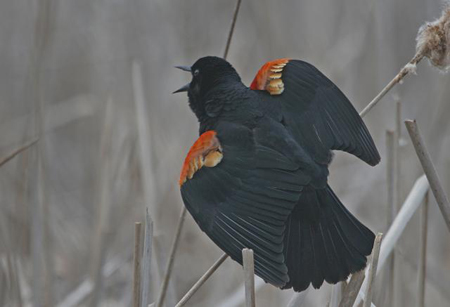
5,000 Red-winged Blackbirds mysteriously died in Arkansas on New Year’s weekend, the first of several mysterious mass bird deaths around the world.
Credit: Ashley Hockenberry
There have been numerous reports in the media about mysterious animal deaths in the United States and abroad. It began with the story of the 5,000 Red-winged Blackbirds that mysteriously dropped from the sky in Arkansas on New Year’s weekend. Shortly after, a large number of fish started piling up on river banks less than 200 miles away. Over the next few weeks numerous stories emerged of other mass animal deaths in places like Louisiana, Kentucky, Italy and Sweden.
It’s highly compelling to tie these stories into a larger conspiracy theory, however most experts agree that each individual case will have a logical explanation generally unrelated to the others. In the case of the Red-winged Blackbirds that died in Arkansas, the consensus of many bird experts is that the birds were probably startled off of a large night roosting concentration by nearby fireworks and in the darkness and confusion birds slammed into each other, buildings, trees, and the ground and died. This and other mortality events are sad and tragic but of far greater overall impact to most bird populations are factors like habitat loss and degradation--the leading cause of decline--as well as issues like climate change, pollution (including from air pollution, pesticides, oil spills, etc.), invasive species, collisions with buildings, telephone wires, and communication towers, and domestic cat predation. The Boreal Forest is of course one of the few places where birds have fewer of these threats and why it is important to protect its still-intact habitat.
Perhaps the most valuable lesson we can take away from these reports is a general awareness of our growing impacts on birds and other animals. The David Suzuki Foundation, a Canadian non-profit dedicated to environmental awareness and protection, poignantly highlights this in their weekly column Science Matters, which is published in 120 media outlets weekly across Canada:
“While the sudden death of wildlife in great numbers is alarming, the unravelling of entire food webs is happening all around us and every day – but in a far less obvious manner. With every patch of forest cut, wetland drained, or grassland paved, our ongoing destruction of wildlife habitat is leading to population declines, and even driving some species to extinction.”
You can read the full column here >
James McCarthy also wrote a nice piece in the Cleveland Plain Dealer explaining all of this. I encourage you to also take a look at this interesting read:

